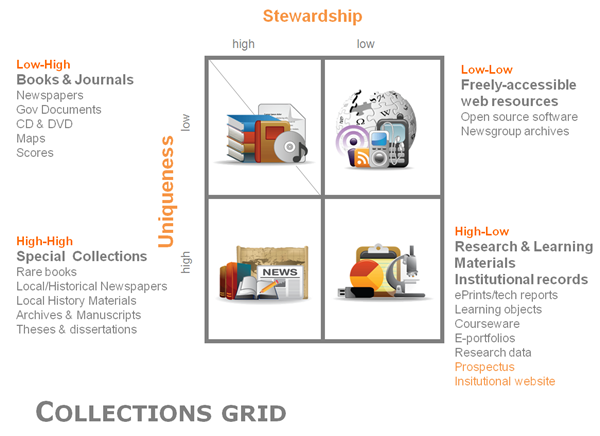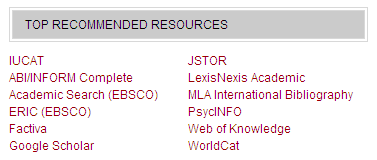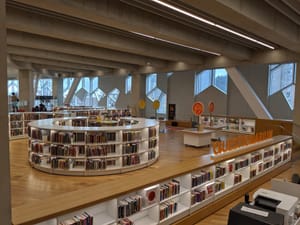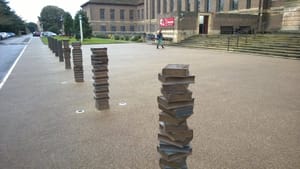A few features I noticed recently on library web-sites …
Oregon State University explicitly notes resources that are unique to the institution …

These include the University Press, the institutional repository, and a range of digitized materials from different collections. With the exception of the University Press, these are materials that come ‘below the line’ in the collections grid we developed a while ago.

In recent years, the institution’s unique intellectual assets have received more attention, whether these are archives and special collections, or newly generated research and learning materials (eprints, data, courseware, digital scholarly resources). In some ways, it is interesting seeing the ‘new’ and the ‘old’ come together in this way. Each is a distinctive contribution of the institution; each is the institution’s responsibility to preserve to the extent it wishes; each involves discussion and construction of a metadata and repository apparatus; each involves engagement with learning and research practice in new ways; each brings to the fore historically the archival concerns of provenance, authenticity, context, … In some ways, it is getting easier to see new scholarly and learning outputs as forming significant ‘special collections’ in the future.
Anyway, I thought it was interesting how OSU clustered and highlighted the ‘unique’ in this way. The second example is similar in that it highlights a particular area of collections, but it is a rather different one …
I was interested to see the University of Indiana at Bloomington highlight top recommended resources on its home page …

We know from various studies that some resources are very popular, but also that there may not be student recognition that they are provided by the library. They are just there, on the network. At the same time, many library websites may still have long lists of resources, favoring completeness and neutrality over convenience and recommendation. This may be changing as metasearch or contextualization through course pages, LibGuides, or other similar approaches becomes more common.
In this context, I thought it was nice that the library here clearly foregrounded a central set of resources and associated itself with them through a recommendation.
And finally, I notice that the Indiana website has an ‘ask a librarian’ box beside the upper central search box. There is a picture of a librarian beside the search box, which changes on each visit. I was looking at the University of Washington library site a while ago, and also noticed a box inviting reader to ‘talk’ with a librarian; it too had a picture of a librarian beside it. It is nice to see the people 😉
Update: I notice a list of the ‘most popular’ databases at the Tri-colleges Subject Portal.
Share
More from LorcanDempsey.net



